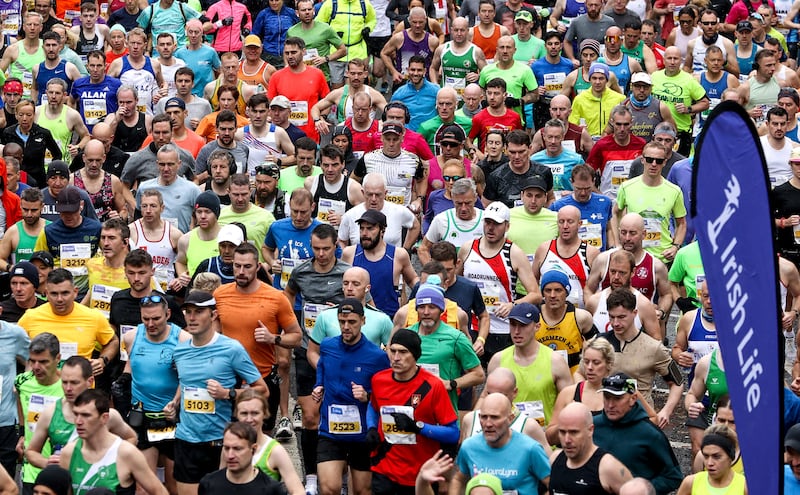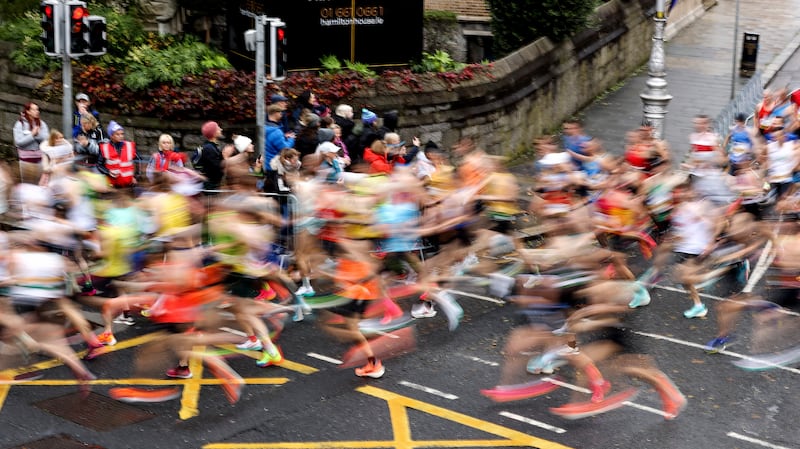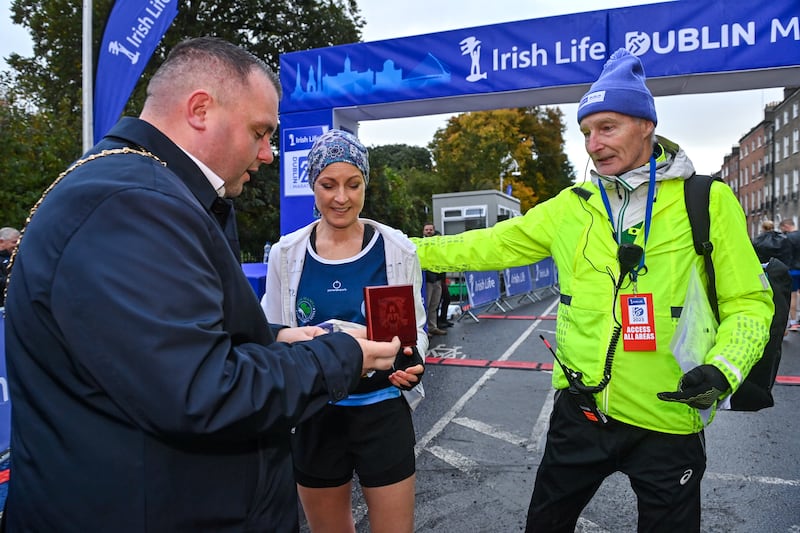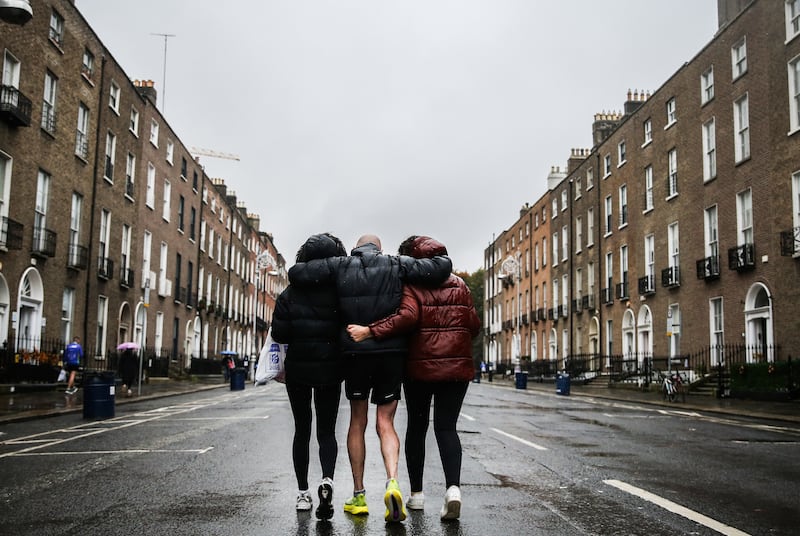In his now 27 years as Dublin Marathon race director Jim Aughney has seen plenty of numbers come and go, some for better, others for worse. But Aughney admits he’s “at a loss” to explain this one.
Of the original sell-out entry of 22,500 for last Sunday’s race, only around 16,540 runners made the start, with 16,347 listed as official finishers – meaning around 6,000 running entries went unused, all despite paying the entry fee of €110.
That represents just over a quarter of the Dublin Marathon entry, far higher than most big city marathons, which typically expect an attrition rate of up to 20 per cent. It was also despite the introduction of a new refund option and an option to transfer an entry, plus a reduced overall entry, down from 25,000 for the 2022 event.
It’s also nearly double what his organising team had anticipated. Aughney had been gearing for around 19,000 finishers, and a no-show of around 3,500 runners, going off the 2019 entry of 22,500, before Covid twice forced the postponement of the event.
READ MORE
“To be honest, I am at a loss to explain it,” Aughney said. “Looking at last year, we couldn’t use that as a data set, because of what happened with Covid. So we were looking at 2019, when we also had 22,500 entries, about 19,000 pick-up and around 18,000 runners.
“With the refund and then transfer window, what we thought was going to happen was we’d have that 18,000, plus the numbers from the transfer, so we were planning for around 19,000 running in the event.

“So right now, we’ve no idea why it was so far below that. We’ll sit down next week, start our review, analyse all this, that might produce some answers. But one year isn’t necessarily a trend.
“We’ve committed to looking again at the refund and transfer windows, the timing of those, for next year’s event. This time last year we were very confident we had an answer for the drop-off, because of Covid, most of the entries had been there since 2020. But I have no idea why the numbers are what they are this year.”
The usual attrition rate of up to 20 per cent is due to a variety of understandable reasons; injury, illness, weddings, funerals, doubts, reality checks etc, in the days, weeks and even months before.
The impact of the double postponement during the pandemic was revealed in the actual number which took part in last year’s event: of the original 25,000 sell-out, only 14,773 were listed as official finishers.
In 2019, that entry limited to 22,500, there were 17,724 finishers; the year before, in 2018, when the entry capacity was 20,000, there were 16,251 finishers.
When Aughney, a Carlow native, took over as Dublin race director in 1997 there were 3,123 finishers; within three years he’d helped double that – 7,156 finishing in 2000. In the years since any adjustments to the entry process were based in part on runners’ feedback.

“It’s just too soon to say we need to do something radically different or not. We’ll also be sending out a survey to runners, probably by the end of next week, asking them what they liked and didn’t like and we’ll do some shaping for 2024 based around that as well. I’m sure people will be looking for a longer transfer window, they are the type of things we expect.
“We can’t deliver on everything they ask for, we deliver on as much as we can and we do take our lead from what the runners tell us.”
For this year, the new refund option was made available in the first two weeks of June; after that, a transfer system was open to runners from July 3rd-July 31st (with a €30 charge to the person receiving the entry), allowing existing entrants to transfer their place to another runner.
Any transfer of entry is otherwise strictly prohibited and could result in the original entrant being banned for life from all future events. Dublin also offers a preferential early entry (taken up by about 50 per cent of runners) which guarantees all those who entered the 2023 race a place next year, whether they showed up or not. There is no deferral of entry.
“We’ve opened preferential entry for 2024 already [for three days] and it’s only after next year’s race when we can really say ‘maybe something is after happening here’. The weather forecast coming into the weekend was quite poor, maybe that had something to do with it. But I think it will take another year’s data before we can really say ‘this model is out-dated, we need to change what we’re doing, and how we do it.’
“That might mean deferring the opening of entry, for 2025, for a period of time. Or moving the transfer window yet again. But if the trend is changing, the numbers that show up and run, all of that, then we do need to change our model.”

Dublin has also expanded the preferential early entry for 2024 for all women who entered the 2023 event, to further encourage more woman entrants. Applications for the remaining entries via the lottery system then went live on the event website on Friday, closing on Sunday, November 19th.
“The idea behind preferential entry, going back to 2017, when we first introduced it, was to reward runners, I suppose, who have supported us in the past. Yes, you will have people who didn’t show up last Sunday and will still get the preferential entry for next year, but they could be those loyal runners, who just missed out this year because of injury, or something else. We can’t analyse all of those, say they deserve it, they don’t, and so on.”
While most marathons work off that expected attrition rate of up to 20 per cent, some fare better than others, this Sunday’s New York City Marathon being among the best (in 2019 it had a record 53,627 finishers). Of 50,000 entrants last year, 47,839 finished. New York also produces the highest completion rate: in 2018, of 52,812 starters, there were 52,121 finishers, an astonishing completion rate of 99.4 per cent.
In 2016, the Dublin Marathon was moved from its traditional Bank Holiday Monday to the Sunday, which Aughney says directly contributed to the first sell-out of runners of 19,500 that year, a 30 per cent increase on 2015.

In 2018, a new entry limit of 20,000 sold-out a full six months in advance; for the 2019 race, the 40th running of Dublin, all 20,000 entries sold out two days after the 2018 race finished (that entry later increased to 22,500).
With the demand for entries fast outpacing the supply, the lottery was introduced for 2020. Keeping the transfer window open as close as possible to the race start would unquestionably help address the 6,000 no-shows.
“We left it as far out as we could this year, because we just didn’t know how many people would avail of the transfer, and we needed the time to react to that.
“There is a possibility we can move it closer to the start, but no matter what transfer window you use, as soon as you close it, you’ll still get a barrage of emails looking for a transfer, for 101 different reasons, like we had this year.”















